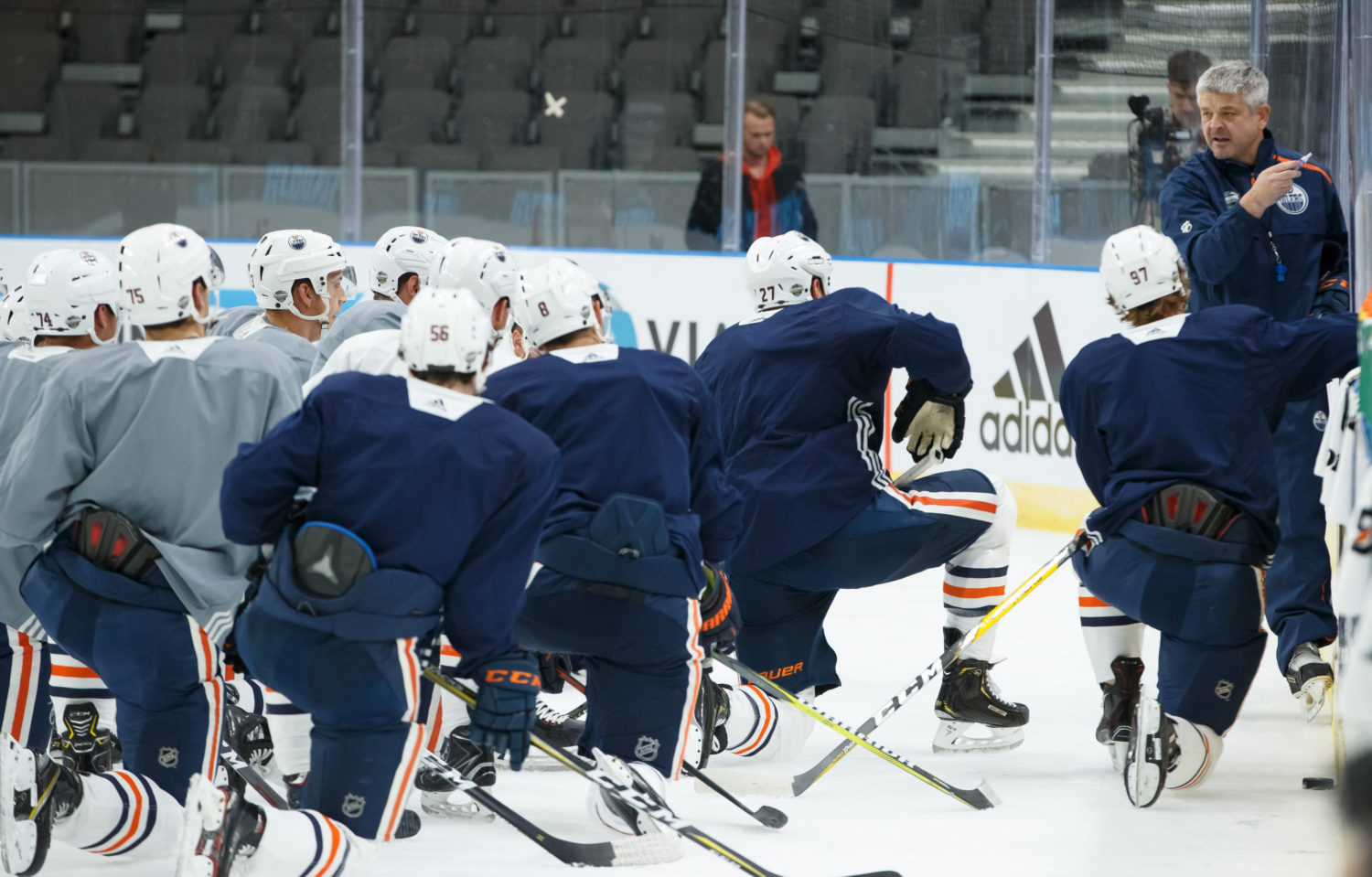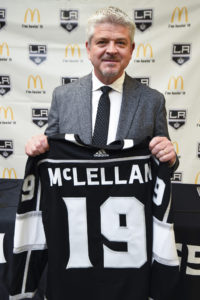The LA Kings will experience arrivals and departures of personnel during a summer in which they’ll attempt to remake their roster in the name of shedding expensive and perhaps more tenured assets while trying to build a younger, sleeker roster. This is an undertaking worth its own novel, and it remains to be seen how the market has evolved – if at all – since the trade deadline.
These personnel transactions are among the things that Todd McLellan doesn’t have control over. But whether in getting the most out of the players under contract, or trying to acquire players of value, both McLellan and Rob Blake are staring down a challenging off-season in the wake of a 30th place finish. They’re armed with a rebuilt pipeline, but also a challenging place from which to re-establish their organizational structure and culture while still owning several lucrative contracts with term tied to players whose production diminished in 2018-19. You’re aware of these circumstances.
Los Angeles is an interesting case study of two extremes. They’re obviously championship-tested and as it currently stands own seven players under contract for 2019-20 who will be at least 32 when training camp opens. But they’ve also made a concerted push to accentuate their youth, and last season eight players made their NHL debuts; seven will be 24 or younger at camp. As it currently stands, there’s no widening middle class within a group marked by both its championship-level experience and a desire to incorporate a younger crop that wasn’t necessarily drafted amidst the organization’s halcyon days earlier this decade.
It’s part of an interesting question I had planned on asking McLellan. Because there’s such a wide range in the distribution of age, how does that affect a coach’s approach to reaching both ranges – particularly one with the reputation of being an excellent communicator, such as McLellan?
“I’ll share with you first before I answer the question,” he said during his introductory press conference Wednesday. “I have two boys that keep me fairly current. They’re 23 and 20, so that helps. As I’m walking around the house, I begin to understand that maybe some of my personal beliefs in how players should carry themselves have changed. Today’s player is different – and when I say, ‘today’s,’ it’s that 18, 19, 20-year-old coming into the league – so staying current is really important and recognizing that. The word ‘entitlement’ comes out a lot, and entitlement’s usually directed at young players coming into the league. I think entitlement can creep into the older players as well where they take it advantage, so I’ve got to blend – or ‘we, as a staff,’ not ‘I,’ ‘we’ – have to blend the old in with the new, make sure the new are professional, that they’re approaching the game and giving everything they have so they earn the respect of the older players. But in turn, the older players have to allow the younger players to progress. They can’t stall their development, they can’t have that glare looking down the bench. It’s going to be a big task. The more we get to accept and believe in that, the better off we’ll be and the quicker it can happen.”
It picked up an interesting conversation presented last week over how best to reach the younger, “modern” professional athlete, especially as the average age across the league continues to come down.
Many questions about individual players will be answered later after McLellan becomes much more familiar with them and acquainted with his surroundings, the community and the organization. But “he started that process early,” as Blake noted, and spoke with Anze Kopitar before the captain left for Kazakhstan to compete for Slovenia in the D-I World Championship, as well as Tyler Toffoli, whom he bumped into in Manhattan Beach last night.
“There are a couple other guys that came in to start training that he’s met with, too,” Blake said. “Similar to I would imagine a lot of coaches – they set the foundation right away to get it started.”
It’s part of the reason why it’s important to keep coaching vacancies from drawing out and taking away valuable time to instill the structure that, as we’ll hear about soon, served as a key influence in targeting McLellan. Before that, more on communicating with younger (and older) players:
Todd McLellan, on what he learned from coaching young Team North America at the World Cup:I learnt a lot at that tournament. First of all, it was an outstanding experience for me individually and I think for that team. Putting that young group of kids together in a short period of time, turn them loose and really let them play was very rewarding. It was such exciting hockey, and I can tell you what I learned there, and I believe it’s very, very true in today’s world is that there’s no fear anymore in young players entering the league. There used to be a pecking order, there used to be a passing of the torch. If they believe they have the talent, they’re exposing that talent to their teammates and they’re prepared to use it. They’ll try and be creative, they want to be creative, there’s no suppression anymore. They’re not taking a backseat to the older players, and I saw that with that team, that they had the courage to try things and to approach it, and I’ve been lucky enough the last few years obviously to coach a couple of the best players in the world, and they’re on the young side, and they have no fear. They bring their game every night. That youthful injection’s really important. It brings energy. It can help the older players, and our older players have to understand that a lot of legwork has to be done by those young guys if we all get together like that.
McLellan, on the organization’s assertion that younger players need to assume more leadership:
It is a challenge, and that’s creating the trust between that youth and the older group. Both have a responsibility. The youthful group has to come in and show the organization throughout – the coaching staff and everybody – that they’re willing to behave properly, they’re professional, they’re working on their games, there are no short cuts for them. That allows the older players to accept them much easier. But the older players also have to understand that they bring something and they’re very important pieces of the plan, that they can help the older players succeed and that they can move the organization forward, so we’ll blend that. It’s a challenge, but we will blend that.
McLellan, on “today’s player”:
There is no fear of authority, I don’t think. [Reporter: Is that good for a coach, though?] I think it is, if the coach understands that. If the coach is very rigid and can accept it, I actually like when a player asks ‘why?’ Not ‘why aren’t I playing more,’ but ‘why do we do this,’ because they’re inquisitive, and the more they know about why they’re doing things, the better chance they have at success. You’re all standing here with phones, most of you. It used to be there are no phones allowed in the locker room. Now, nobody can survive without their phones. That’s how much it’s changed. Players go to their phones for feedback. Right after the game, you guys are all in the locker room, they change in 10 seconds and they’re out, but they’re all going to their phone and they’re getting feedback from their parents and their wives and their girlfriends and their agents. … We don’t allow it in our house, but if we sat down at our table for dinner, we could have a very quiet dinner and still communicate because everybody would just be texting each other around the table. But that is that generation. Buses are quiet now. You win a big game, it’s still quiet on the bus because they communicate via phone. But to fight it and not accept it is wrong, in my opinion. To understand it and accept it is I think where the game is going and the athlete’s going, so we’ve got to meet them.
McLellan, on whether using video helps answer the “why” question younger players often ask:
It does. Notoriously, as coaches we’re in repair mode all the time. We open up a hood of a car, and we want to fix things. If we keep fixing the same thing over and over again and we really don’t understand why it’s broken, it’s insanity. The players need to understand why we do things, why we’re trying to fix things, and visually they’re visual learners. They want to see things, they like to watch things – and they especially like to watch themselves.
McLellan, on how to bridge the gap between older and younger players:
We have to make sure the standards are set at both levels. If the older players are doing it right and establishing it, we’ve got to catch them doing it right and reward them for it. If the younger players are doing it right, we’ve got to do the same thing. But you can’t treat one group more aggressively than the other. You’ve got to share that you’re prepared to react and hold both youth and experience the same way. [Reporter: The reason I ask you is because in all sports, generally the older look down on the young players as being goofy and don’t realize that was them 10 years earlier.] That’s exactly right, and they’re not very accepting of it, but we can go back. Our manager here played when Brownie entered the league, and I’m sure Brownie’s matured a ton. He’s got his family at home now, he’s experienced Cups, he’s won, he’s lost, and that’s part of growing up, though. There’s a huge difference between my 23-year-old and my 19-year-old, and it’s just part of growing up and maturing. We’ve got to put that together and get them on the same page.
McLellan, on any social media “rules”:
No. [Reporter: Ban Fortnite?] I’d like to, but no. The social media, I’ve been around the players. Brent Burns is a huge social media guy. Players, this is where it’s changed a little bit. They’re their own little entities, as well. They have their own little corporations, they just happen to wear equipment and represent themselves on a nightly basis, and all the more power to them. But the social media is part of our game, and I think the fan wants it now. We’re not going to ban it, we’re not going to censor it. We’d like to think the players make good situations when they’re in those situations. They are respectful of the opponent but certainly respectful of our fanbase and our organization here when they’re on it.
–Lead photo via Andre Ringuette/NHLI




Rules for Blog Commenting
Repeated violations of the blog rules will result in site bans, commensurate with the nature and number of offenses.
Please flag any comments that violate the site rules for moderation. For immediate problems regarding problematic posts, please email zdooley@lakings.com.